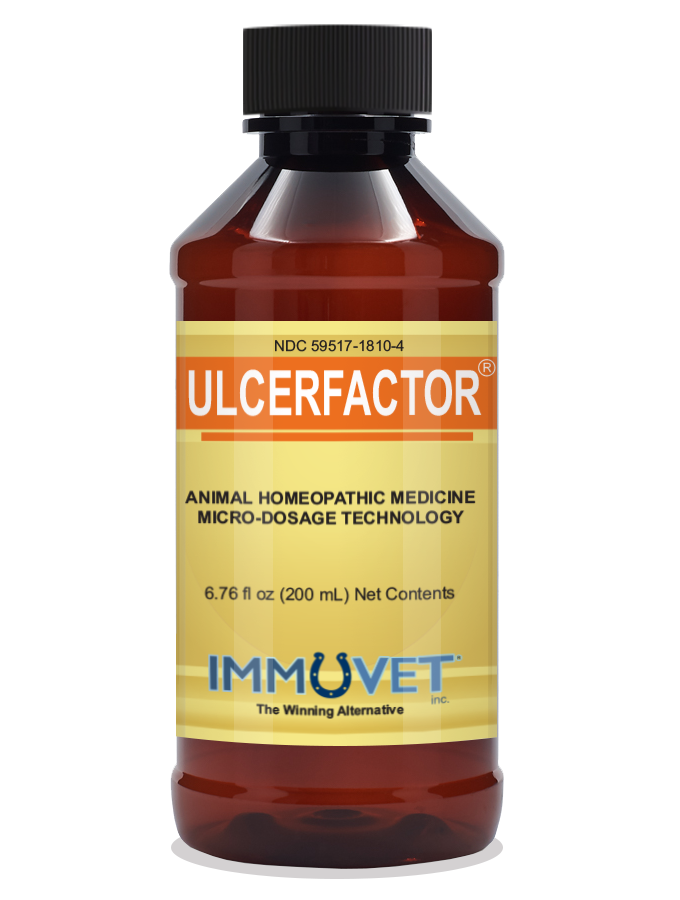What are ulcers?
The term ulcer refers to a break in or the erosion of the lining of the esophagus, stomach, or small intestines. The depth of the erosion or size of the break determines the severity of the ulcer. Stomach ulcers occur primarily in the squamous region of the stomach, but can also occur in the glandular mucosa region of the stomach. Ulcers can also occur in the first part of the small intestine (duodenum) and the esophagus. Studies have shown that stomach ulcers are very common, with up to 90% of Standardbred and Thoroughbred horses in race training being affected. The clinical signs of ulcers may include poor athletic performance, weight loss, and colic. Horses may also have an unthrifty appearance and mild diarrhea. In foals, teeth grinding and excessive salivation are common.
What causes ulcers to form?
Ulcers are caused by a variety of factors, including diet and feeding management, the stress of training and/or disease, medications, and bile acid reflux. These causes are quite different from those of humans, with 90% of duodenal ulcers and 70% of gastric ulcers being caused by the bacterium Helicobacter pylori. Diet and feeding management plays the biggest role in inducing ulcers in horses. By nature, horses are grazing animals, spending much of their day feeding. While grazing, the horse has a constant flow of saliva and grass going into the stomach, buffering the stomach acid. However, there are many horses (i.e., racehorses and high-level event horses) that are managed as meal-eaters rather than being allowed to feed or graze continuously. They receive dry hay and concentrates (mixtures of grain, crushed or whole, along with vitamins and minerals combined in various forms or textures to compliment the nutrients found in the hay) year-round. Feeding high volumes of concentrates increase the horse’s production of volatile fatty acids. This combined with meal-feeding, results in sudden drops in gastric pH and damage to the cells in the stomach and intestines. An alternating regimen of feed deprivation for 24 hours followed by free choice hay for 24 hours resulted in the erosion and ulceration of the gastric mucosa within as little as 48 hours of cumulative food deprivation. Horses that are anorectic (not eating) or partially anorectic because of an underlying medical condition can develop erosions and ulcers in their squamous mucosa in one to two days. Studies showed that feeding horses alfalfa hay and grain resulted in a higher gastric pH than feeding them grass hay. In addition, the stress of the training on the horse causes the increased release of corticosteroids and a subsequent decrease in blood flow to the stomach lining. This interferes with the natural protective mechanisms of the stomach and results in more damage from stomach acids.
How can ulcers be prevented?
Horses should be fed no less than 50% (preferably >70%) of their dry weight in long, dry hay or pasture. If the horse is required to take in high levels of concentrates (greater than 2.5 lbs twice a day), they should be fed more often and in smaller amounts (i.e., 1.25 lbs every 6 hours). Since this is a labor-intensive process and compliance will be variable, the use of computerized or mechanical feeding systems may help increase compliance. Turnout or, better yet, access to pasture on a daily basis is a good way of reducing the horse’s stress and provides the horse continuous access to nutrients. Horses that are being deprived of food for extended periods of time (greater than 12 hours) should be carefully monitored for the development of ulcers.
References
Gastric Ulcers in the Adult Horse. Ministry of Agriculture, Food and Rural Affairs, www.omafra.gov.on.ca/english/livestock/horses/facts/info_gastric.htm.
Immuvet® Products are manufactured by Amino Cell Inc.


